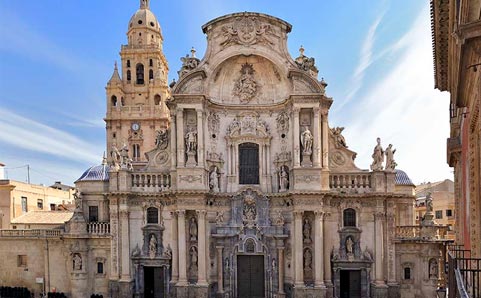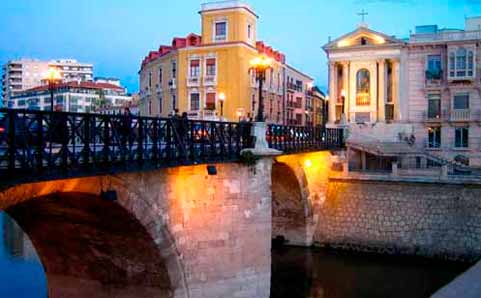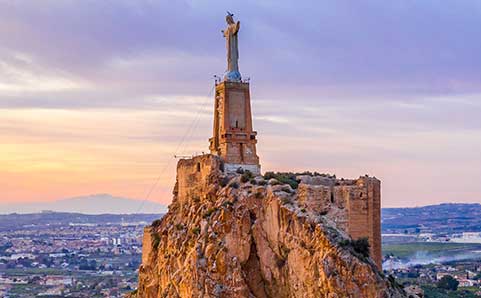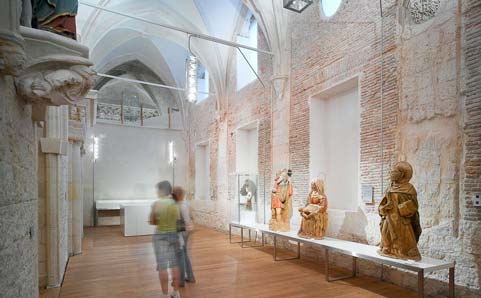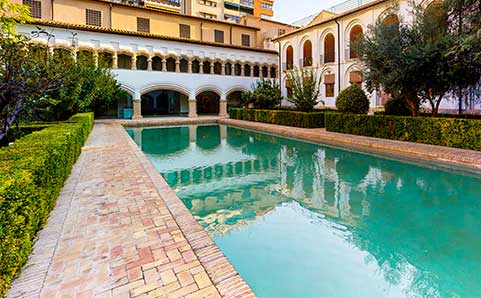Route of the Baroque Churches
Tourist circuit focused on the most important religious sites in the city, such as the churches of St. Andrés, San Nicolás and St. Domingo. For greater convenience it is divided into two stages.
First stage
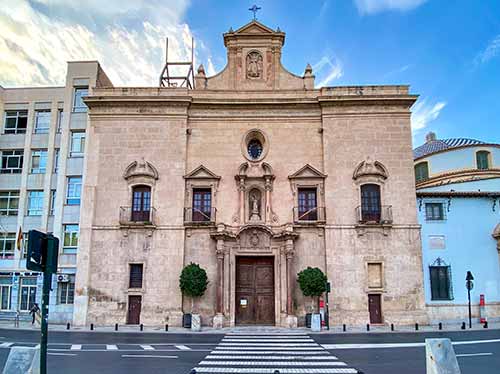
1
St Andrew's Church.
The church of St. Andrew was completed around 1689 and houses the chapel of the Virgin of the Arrixaca, the former patron saint of Murcia, which is differentiated as if it were a church within a church, and had to be relocated when work on the current floor was completed. It has important works by Salzillo: San Andrés and San Roque. The church has a Latin cross floor plan, with side chapels between buttresses and a choir loft at the foot of the church. The central nave is of ample proportions, with a barrel vault with lunettes, divided into seven sections by means of sash arches, two of which, of smaller dimensions, correspond to the choir.
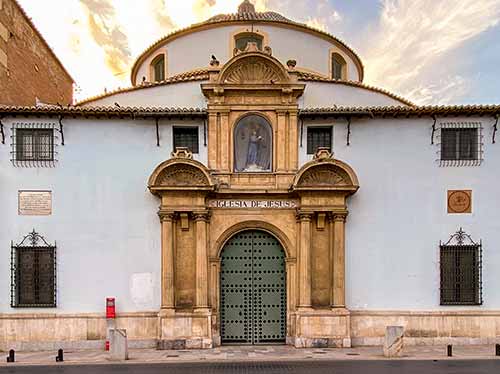
2
Jesus Church.
The Church of Jesus is part of the Salzillo Museum. The processional floats that the sculptor Francisco Salzillo made for the aforementioned penitential institution are exhibited inside the church. With an octagonal floor plan, it was built around 1670 and completed at the end of the 17th century as the church of the Brotherhood of Jesus. It is a real theatre designed to show the mysteries of the Passion. Salzillo created the famous processional steps for the Good Friday morning processions, achieving a harmonious setting between architecture and sculpture. The original paintings by Pablo Sístori, dating from 1792, are still preserved in the stands. It was declared a National Monument in 1935.
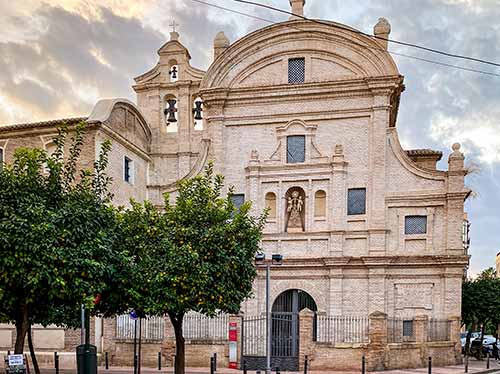
3
Church of Agustinas Descalzas.
The convent of the Augustinian Nuns of Corpus Christi is a monastic complex belonging to the female branch of the Order of Saint Augustine, located in the Agustinas Square, in the district of St. Andrés. The convent tells the story of a community established in 1616 by a group of nuns from Almansa. The church is dominated by an important altarpiece, erected around the middle of the 18th century to house the image of Saint Augustine, the founder of the order, a monumental sculpture by Salzillo. Another work of great charm to be found inside is St. Cecilia, by the sculptor Roque López; a singular version of the protector of music accompanied by a domestic organ.
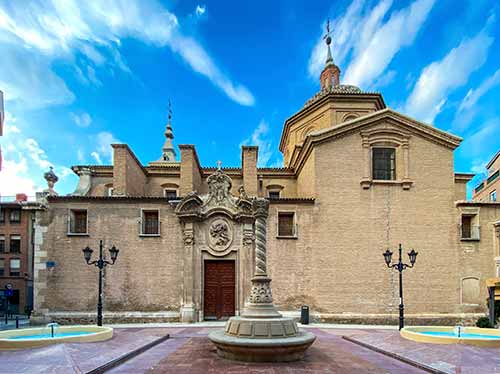
4
Church of St. Nicolás de Bari .
The church of St. Nicolás de Bari is one of the traditional parishes in the historic centre of Murcia, whose origins date back to the Christian conquest, although the current building dates from the first half of the 18th century and is one of the best examples of Murcia's Baroque style. This temple is very spacious and has great constructive richness. The large number of ornamental elements give it a more baroque feel. Inside, the main altarpiece also adds to the splendour of the temple, which also conserves important sculptures from the 17th and 18th centuries by Salzillo, Alonso Cano and Pedro de Mena.
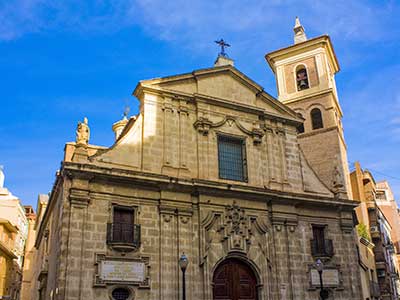
5
St. Peter's Church.
The church of St. Pedro is one of the traditional parishes in the historic centre of Murcia, located between the square of the same name and the Square of the Flowers. Its origins date back to the conquest of Murcia, although the current building is the result of a reconstruction from the beginning of the 17th century with interior reforms carried out in the 18th century. This church is smaller than the previous ones. It has an important ornamental function as far as its liturgical furnishings are concerned, especially that of its main chapel, whose patronage was exercised by the Saavedra family, and a monumental altarpiece by Nicolás de Rueda with sculptures by Salzillo and Roque López. The chapel has the image of the patron saint, made by Salzillo.
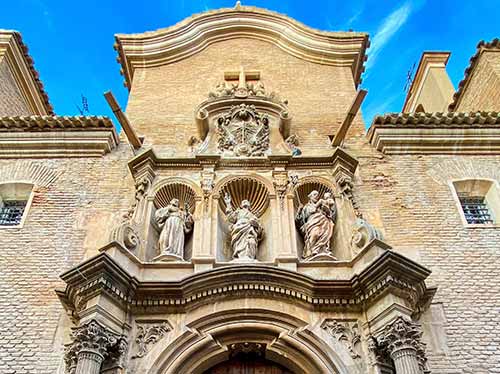
6
Former Convent of Veronicas and Church of El Salvador.
The church is a Baroque construction with a Latin cross floor plan with interconnected side chapels, a dome-covered transept and a main chapel. At the foot of the nave is the low and high choir with its side galleries leading to the tribunes. The former church of St. Salvador, now converted into an exhibition hall, was the site of a primitive convent of Franciscan nuns dedicated to St. Verónica. The façade, finished in 1755, offers a masterly solution in the arrangement of its oblique elements and the power of its cornice by adapting the design to a space as difficult to contemplate as the narrow street it opens onto.
Second stage
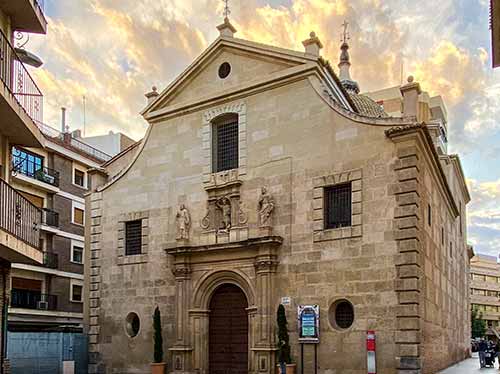
7
St Michael's Church.
Of medieval origin, it underwent extensive alterations until the 18th century. Preserved from destruction and later transformations, the interior is a reflection of the splendour given to Murcian churches in the 18th century, both for the formal unity of its altarpieces and for the brilliance of its gilded architecture. The whole church is a showcase for the sculptures by Francisco Salzillo, which are scattered throughout the building. Since 1949 it has been the headquarters of the Brotherhood of the St. Cristo de la Misericordia, which parades here on the evening of Good Friday. However, the small size of the door means that the procession departs from nearby St. Esteban.
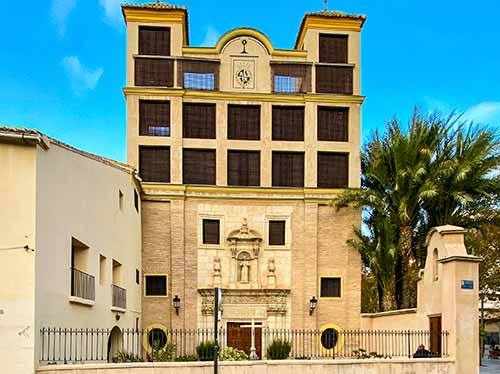
8
Church of the Convent of St. Claire.
It belongs to the complex of St. Clara la Real (Monastery and Museum of St. Clara), which has undergone various transformations that have made the convent an artistic nucleus of the first magnitude. Independently of the visit to the Museum, the Baroque convent temple has a rich collection of altarpieces and images. Of particular note is the original altarpiece-templete or tabernacle that presides over the church, of clear Italian inspiration, where the sculptures are freed from the frontalism that an attached altarpiece would have imposed on them, the work of Jose Ganga Ripoll and Francisco Salzillo (1755).
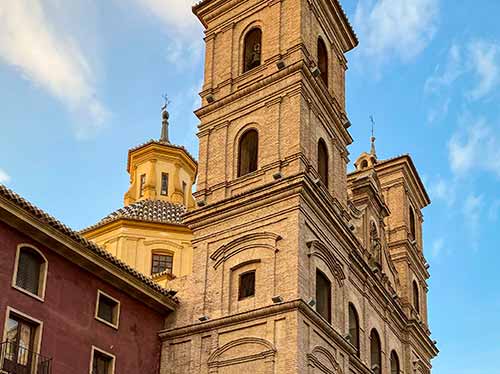
9
Church of Saint Domingo.
The Church of St. Domingo and the adjoining Chapel of the Rosary are the remaining constructions of an old monastic complex of the Dominican Order located in the central square of St. Domingo, which it presides over and to which it gives its name. Its origin dates back to the 13th century, although the ensemble currently preserved corresponds to the 16th century (Chapel of the Rosary) and the 18th century (Convent Church of Santo Domingo). The uniqueness of the church, connected to the Chapel of the Rosary (16th century) and open to two fronts of the city, meant that it had two façades at its ends: the western one, facing the Romea theatre, and the one built in brick, facing the St. Domingo Square.
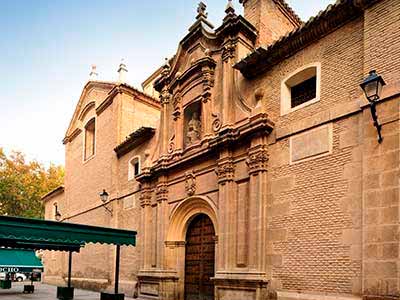
10
Church of the Convent of St. Ana.
The convent of St. Ana, or as it is popularly known, the convent of Las Anas, is a monastic complex belonging to the female branch of the Dominican Order, located in the St. Ana Square. The convent dates back to the 15th century, although the building that can be seen today dates from the 18th century. It is one of the most representative examples of Murcia's Baroque style. Founded in 1490, it had a primitive church built in 1611, of which its old main altarpiece is preserved, today dedicated to St. Miguel. The current church was built in 1731, its famous main altarpiece is the work of José Ganga and the old chapel houses the group of St. Anne teaching the Virgin to read, the work of Salzillo.
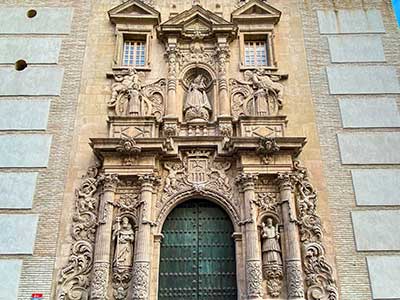
11
Conventual Church of La Merced.
The church of La Merced is a religious temple belonging to the former convent of the Order of La Merced, built on the current site in the 16th century. The church is currently run by the Franciscans and the former convent is now occupied by the Law Faculty of the University of Murcia. The great sculptural display on the façade and in the interior is outstanding. The main altarpiece was erected in 1744 according to the designs of Jaime Bort, on the main façade of the cathedral. The sculptures by Nicolás Salzillo and the panel by Senén Vila stand out. The oldest part of the architectural complex is the cloister, now the Faculty of Law of the University of Murcia...
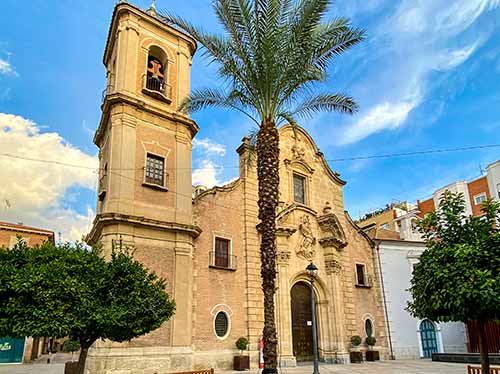
12
Church of St. Eulalia.
Of medieval origin, the current building was built in the second half of the 18th century, and is one of the last examples of the Baroque-Rococo style in the city. Built in 1765, it has one of the most dynamic façades of all the religious architecture in Murcia... Pablo Sístori painted the perspective altarpieces of the main chapel and the transept using the trompe l'oeil technique. This church has several sculptures by Salzillo. Next to it, in the small space between the church and the Arab wall, is the Chapel of St. Jose, built by the carpenters' guild at the beginning of the 18th century.
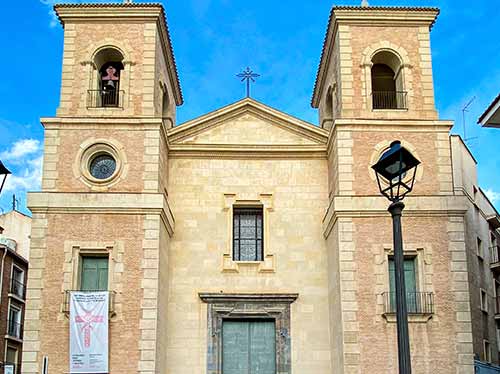
13
St John the Baptist Church.
The Church of Saint John the Baptist has existed in Murcia since medieval times under the name of St. John of the Real and later St. John of the Rabal. The church changed its name to St. John the Baptist when it was rebuilt in the 18th century. The symbolic importance of the altar stands out thanks to a monumental baldachin. In addition to the venerated Cristo del Rescate, the church preserves outstanding works of art: San Isidro Labrador, by Salzillo, Sainte Maria de la Cabeza, by Juan Porcel and the 18th century choir stalls.
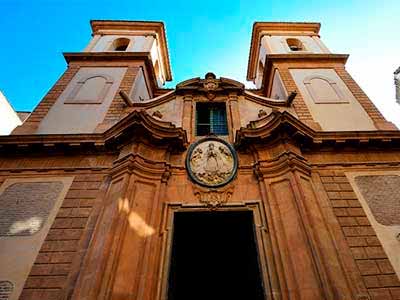
14
St John of God Church.
The Museum of the Church of St. John of God is one of the headquarters of the Museum of Fine Arts of Murcia, which houses an important collection of religious imagery from the 15th to the 20th century. The old church, dating from the 18th century, is located near the Cathedral. It formed part of the hospital complex of St. John of God, which was previously a Templar hospital, and was originally the city's Alcázar Mayor, of which valuable remains can be seen in the subsoil. Its elliptical floor plan is perfectly suited to the purpose of its foundation: the adoration of the sacrament in a famous monstrance. Today it is a museum and has important Arab remains in its basement.
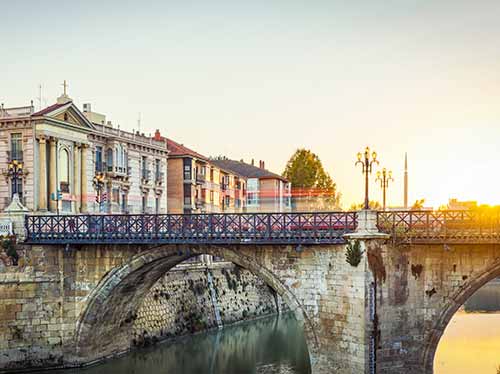
15
Bridge of Dangers or Old Bridge.
The old bridge or bridge of dangers is a stone arch bridge over the Segura River dating from the 18th century. At the end that connects with the Carmen neighbourhood is the Templete de la Virgen de los Peligros, in neoclassical style, which houses the figure of the Virgen de los Peligros, by Carlos Cayetano Ballester. The people of Murcia still have a great devotion to this Marian image. This shrine gives its name to the bridge which is also known as Puente de los Peligros (Bridge of Dangers). Both the bridge and the Virgen de los Peligros are mentioned in the popular zarzuela La alegría de la huerta (1900) by Federico Chueca.
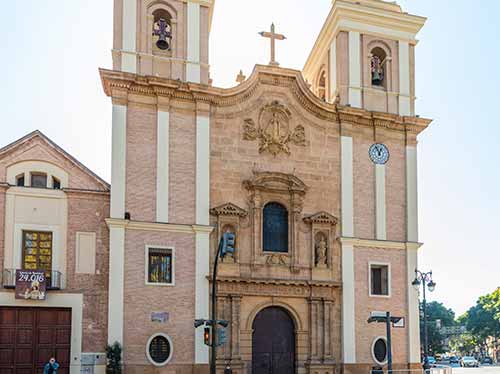
16
Carmel Church.
Crossing the Old Bridge, the walk takes us to the Church of El Carmen, the former convent of the Carmelitas Calzados, located in 1586, after certain clashes with the Augustinians, on the site of the hermitage of the glorious San Benito, outside the city walls. When the old convent was demolished in 1835, all that remains is the present church, begun by the friars in 1721 in the time of Belluga and consecrated in 1769 by Diego de Rojas Contreras, benefactor of the convent, who was in charge of the now disappeared altarpiece by Perspectivas de Sístori and the image of the patron saint. The church is the canonical seat of the Archconfraternity of the Most Precious Blood of Our Lord Jesus Christ, which parades during Holy Week in Murcia...
